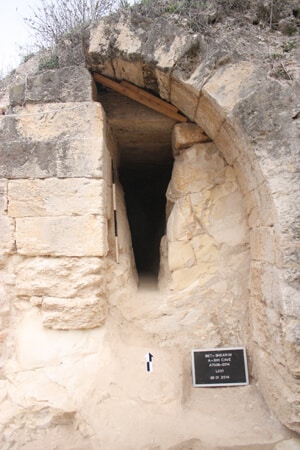During new excavations being conducted in Beit Shaarim National Park (near Kiryat Tivon), a huge water reservoir and an impressive water tunnel were discovered, these important findings shed light on an ancient and unknown chapter in the history of Beit Shaarim. It is about the period of the 1st century AD about 150 years before the time of Rabbi Yehuda Hanasi.

During new excavations being conducted in Beit Shaarim National Park (near Kiryat Tivon), a huge water reservoir and an impressive water tunnel were discovered, these important findings shed light on an ancient and unknown chapter in the history of Beit Shaarim. It is about the period of the 1st century AD about 150 years before the time of Rabbi Yehuda Hanasi.
As part of preparing the cave as a visitor center, an excavation was conducted to study the water reservoir and the tunnel that led to it. The excavation was led by Dr. Tzvika Tzuk, Chief Archaeologist of the Nature and Parks Authority and Dr. Yossi Bordovich, Archaeologist of the North District of the Authority and in cooperation with the Antiquities Authority.
The excavations of the burial caves that were conducted in Beit Shaarim National Park many years ago, overlooked an impressive water plant located near Cave No. 1 (Cave of the Sepulcher).
This place became known as the Slick Cave while it was used during the British Mandate as a secret weapons depot and range for the Haganah. The training destroyed the entrance and part of the water transport system.
The only information that existed until the beginning of the new excavations was the indication of the place on the map of the Beit Shearim caves, mentioning it as a cistern or by the Arabic name Ma'rat al-Sih (cave of the cistern), but now it has become clear that it is a huge water reservoir, measuring 25 m in length, 7 m ' wide and at least 6 m deep, which includes two large compartments on the sides, its volume is estimated at about 1000 mXNUMX.
The plaster on the walls of the reservoir is made of one layer in a white on gray shade typical of the 1st century AD.
At the entrance, on the south side, an impressive and plastered staircase has survived, with the wall of the reservoir on one side and a plastered railing on the other. The area where the water enters the reservoir was indeed destroyed during the preparation of the slick, but at a distance of about 15 m to the west of it there is a plastered and graded facility (it may have been used as a mikvah originally) that served as a settling pit for an impressive water tunnel coming from the north and exposed for a length of about 20 m.
The tunnel was cut as an open trench and was later closed with a roof made of stone slabs while incorporating construction into the carved sides. Its impressive dimensions allow people to enter inside.
The tunnel, which was preserved in its entirety in the section that was excavated, led runoff from the slopes of Beit Shaarim hill from the nearby ravine to the water reservoir.
According to Dr. Tzvika Tzuk, Chief Archaeologist of the Nature and Parks Authority: "These are important findings that shed light on an ancient and unknown chapter in the history of Beit Shaarim. It is about the period of the 1st century AD, about 150 years before the time of Rabbi Yehuda Hanasi, which help us paint a picture of daily life in ancient times."

One response
Beautiful place, highly recommend it.